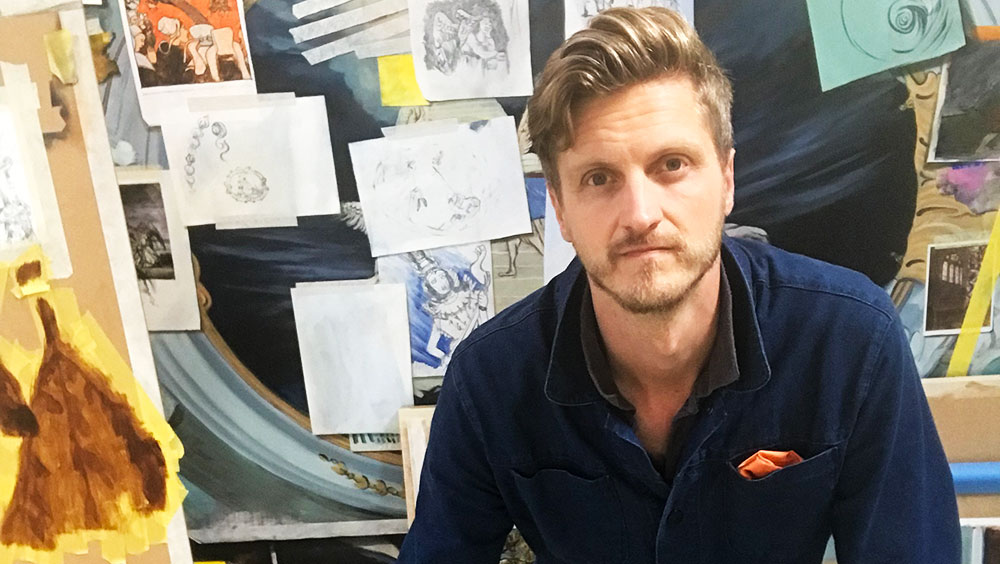
Alastair Gordon. Photo: Alastair Gordon.
by DAVID TRIGG
A skilled closeup magician soon proves the adage that the hand is quicker than the eye, yet the slow and methodical hand of the trompe l’oeil painter can similarly cause viewers to question what they see. Alastair Gordon (b1978, Scotland) prefers the latter. The London-based artist’s meticulous paintings draw on the rich tradition of illusionistic painting, specifically a curious sub-category of trompe l’oeil called quodlibet, which emerged in the late-17th century and is commonly associated with compositions of everyday objects – letters, pamphlets, printed images and other domestic ephemera – shown hanging on walls or stuffed into letter racks.
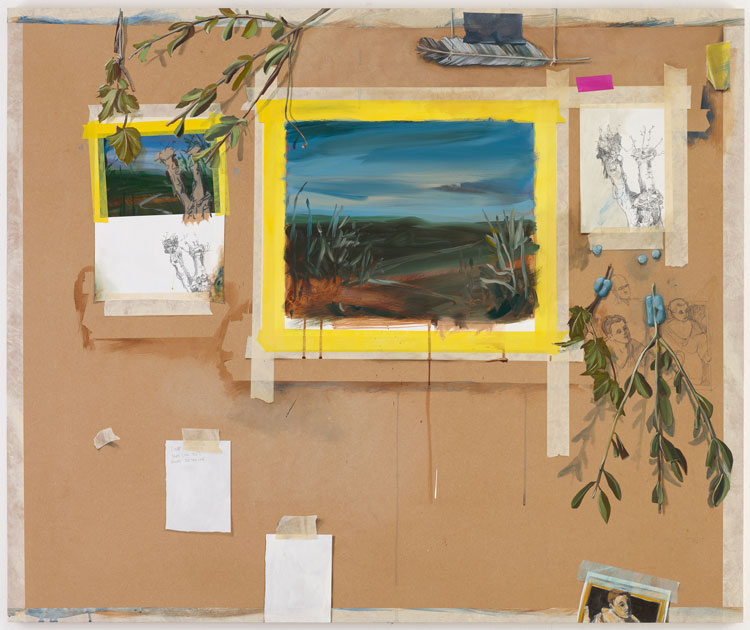
Alastair Gordon. Improvisation, 2021. Oil and acrylic on mdf, 100 x 120 cm. © Alastair Gordon. Courtesy the artist and Aleph Contemporary. Photo: Anna Arca.
Reimagining quodlibet for the 21st century, Gordon similarly grounds his approach in the quotidian; his focus, though, is the stuff of the artist’s studio: paper, masking tape, drawings, postcards and other materials relating to the making of paintings, all rendered with exacting detail on wooden boards. In causing you to look twice, these ostensible snapshots of the artist’s studio reflect his concerns with the nature of representation, authenticity and artifice, and finding value in the overlooked. Inspired by the 16th- and 17th-century still life painters of northern Europe as much as contemporary figures (including the Scottish artist Lucy McKenzie and the Dutch painter Kees Goudzwaard), Gordon performs a delicate balancing act, deftly mixing illusionistic figuration with passages of painterly gesture and pure abstraction.
Yet for all their illusionism, Gordon’s compositions don’t hide their status as paintings. They invite us to peer closer, to revel in the painted mark and then ponder the gap between what we thought we initially saw and what became apparent on closer inspection. Essentially, these are paintings about painting, both the delight the artist takes in the struggles of making and the power that the medium has to “lift us from the detritus of everyday life”. Although Gordon’s interest lies in the role of images in shaping societal attitudes and beliefs, his meditative paintings deliberately eschew the daily deluge of digital imagery, messaging and viral content. His is a quieter world in which still life becomes a vehicle for addressing weightier concerns regarding truth, beauty, death and the value of life.

Alastair Gordon. Memento Mori, 2014. Oil on gaboon marine ply, 50 x 40 cm. © Alastair Gordon. Courtesy the artist.
On the occasion of his exhibition with Aleph Contemporary, Studio International spoke to Gordon about his recent paintings, how lockdown has affected the direction of his work, and how his ideas about art’s value have inspired his new book, Why Art Matters, a candid reflection on the importance of the creative arts in society as seen through the lens of his Christian faith.
David Trigg: Your exhibition at Aleph Contemporary takes its title from a little-known form of illusionistic painting known as quodlibet. As with trompe l’oeil, which means “to deceive the eye”, it, too, is concerned with creating slippages between reality and illusion. What distinguishes quodlibet from trompe l’oeil?
Alastair Gordon: The term quodlibet means “what you will”, from the Latin. Originally, it was a musical term describing compositions that combined several well-known melodies. In the late-17th and early 18th centuries, Dutch and Flemish painters such as Edward Collier and Gysbrechts applied it to paintings of everyday objects that appeared to have been left lying around, pinned on boards or hung on letter racks. Quodlibet distinguishes itself from other forms of trompe l’oeil because it favours common domestic objects and ephemera, often presented in low relief with the illusion of spontaneity.
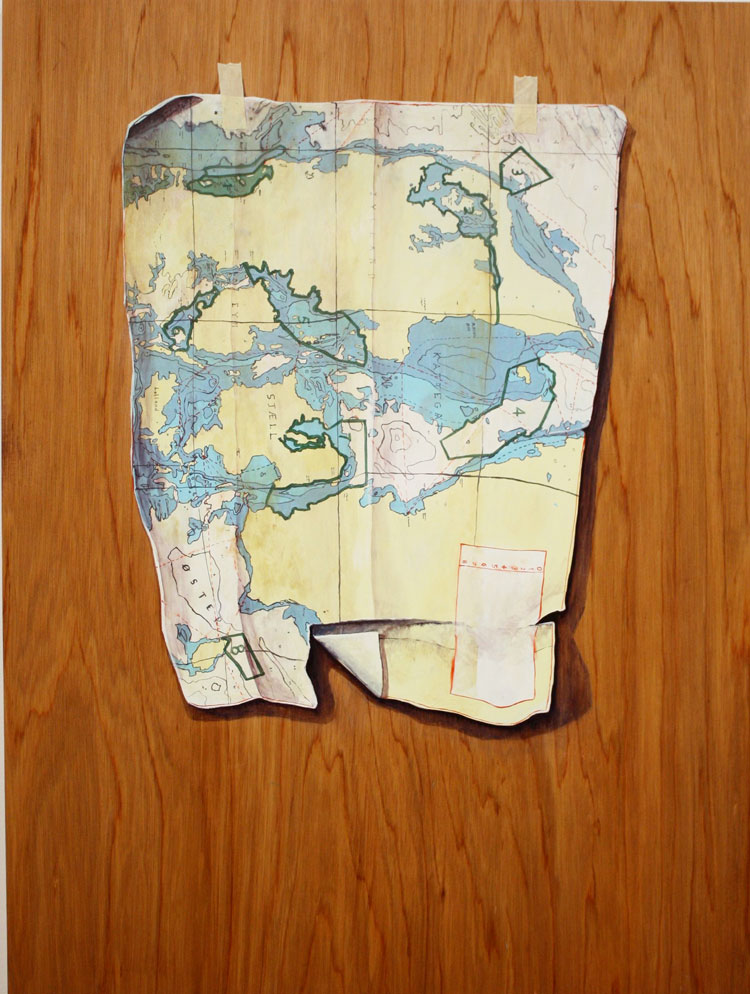
Alastair Gordon. Nautical Map, 2013. Oil on gaboon marine ply, 120 x 90 cm. © Alastair Gordon. Courtesy the artist.
DT: Where did you first encounter quodlibet painting and what attracted you to the genre?
AG: In 2013, I had a show in east London. The gallery used to be an old Danish sailors’ hostel, and I made paintings of historical maps and memorabilia referring to that history. I painted the objects on to wooden panels as if they had just been pinned up and a friend wrote a review saying: “Alastair Gordon refers to the quodlibet tradition” – but I had never even heard of the term! So, I did some research and discovered this really fascinating tradition that connected with my interest in the relationship between reality and illusion – between things that are real and things that are fake.
DT: Another Scottish painter interested in the possibilities of quodlibet is Lucy McKenzie. Her paintings of noticeboards feature items of ephemera and pieces of cultural history, reflecting a wide range of interests and concerns, from political ideologies to feminism. Your work, however, seems more focused on the mechanics and processes of painting itself.
AG: Yes, my work is more about the materiality of paint. My interest is in how paint and painted images function. Quodlibet is a vehicle that allows me to explore these painterly concerns. Many of the early quodlibet painters were concerned with painting printed materials, so you have original paintings of mechanical reproductions. Today, we live in a world of digital reproduction and, while my painting doesn’t specifically explore digital media, that’s the backdrop: the relationship between the real and the hyperreal, things that present themselves as an illusion but have an authenticity of their own.
,-2015.jpg)
Alastair Gordon. Sacrament (lateral composition), 2015. Oil on wood, 30 x 20 cm. © Alastair Gordon. Courtesy the artist.
DT: Your quodlibet paintings depict various configurations of painted imagery, postcards, reproductions, papers and other scraps of studio ephemera, all stuck to wooden boards with masking tape. They are very much like snapshots of a painter’s studio wall. How does a painting typically start?
AG: It begins with a collage. I print out photographs, drawings and sketches, and then stick them on to wooden boards. When I find an assemblage that works, I’ll take some photographs of it, make some drawings and then rearrange things again. From there, I’ll make another drawing, which then becomes the starting point for the final composition, but usually, by the time I get to painting, it all changes again anyway.
DT: Why do you paint on to wooden boards?
AG: The reason is that it’s very easy to sand back the paint – wood is much more forgiving than canvas. By the time the paintings are finished, they often look like drawing boards with the masking tape sufficing as a frame, but some end up looking like studio walls with splodges and drips. Those marks aren’t artifice, they come from the process of making the painting itself. So, you have this coming together of both the illusory and the real, the authentic and the fake.
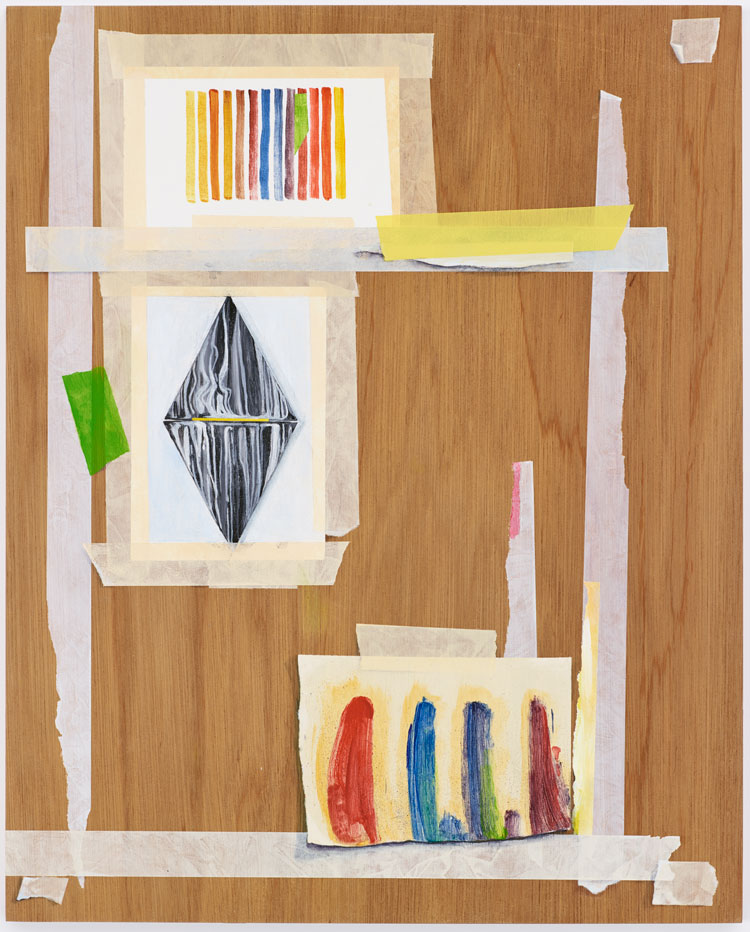
Alastair Gordon. Studio Remains, 2016. Acrylic on gaboon marine ply, 50 x 40 cm. © Alastair Gordon. Courtesy the artist.
DT: Is the wood grain that we see in some of your works painted or the real thing?
AG: Usually it’s actual wood grain. I prepare the surface in a way that exaggerates the grain, so at first sight it’s not clear whether it’s painted or not. But as you come closer, the illusion reveals itself. That’s the heart of trompe l’oeil: the deception of the eye. Trompe l’oeil is not photorealism, it’s not meant to convince you with your nose up in front of it, you’re meant to get close and then have this “aha!” moment when the painting reveals itself as a painting. It’s like breaking the fourth wall in theatre.
DT: Masking tape is a conspicuous element of your paintings. Sometimes its presence has a practical function, appearing to fix various elements to the wooden panel, at other times it serves no function, verging on the abstract.
AG: It’s partly a signifier, a nod to the processes of painting. Most artists I know, particularly painters, have masking tape in their studio. It’s one of those ubiquitous items. So, it’s partly in reference to the making and construction of paintings – the tape is a remnant, like the residue of a painting that’s been pulled away from a drawing board. More recently, it’s become a framing device and I’ve been making paintings that have a perimeter of tape, which can be read as an aperture, so it goes back to the romantic idea of a painting as a window. In 2014, I made a series of paintings that looked like grids of masking tape, a sort of a hard-edge painting where the tape took on a different function; it was a form, a shape, an abstraction, almost like a Barnett Newman or Callum Innes painting. I felt that I’d achieved everything that I could with that subject and the final work in the series was a very thin sliver of tape, just at the edge of the painting. But masking tape keeps coming back.
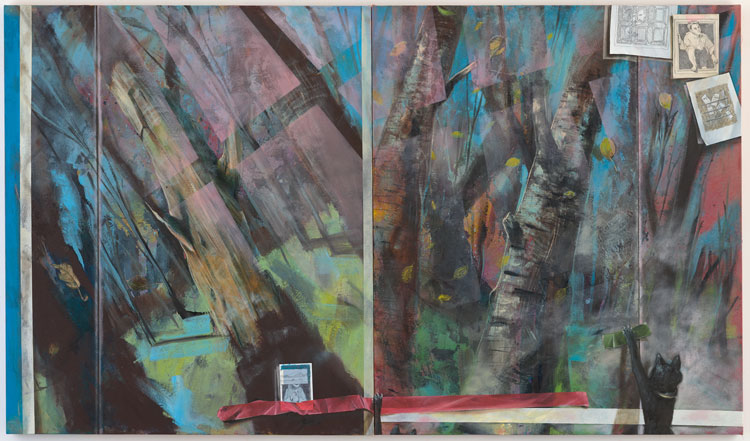
Alastair Gordon. The Betwitching Hour, 2021. Oil, acrylic and pencil on canvas, 120 x 240 cm. © Alastair Gordon. Courtesy the artist and Aleph Contemporary. Photo: Anna Arca.
DT: A long strip of tape divides the woodland imagery in The Bewitching Hour (2021), a large painting that juxtaposes a painterly, gestural style with illusionistic elements.
AG: Recently, I have become more interested in the gesture and the mark – things I was concerned with as a student. From 2015, I started to be known for making these very tight, hyperrealistic paintings but I’ve since become more interested in the painterliness of painting and the evidence of the artist’s hand. I started making these quodlibet paintings that looked like gestural paintings. They still have the hard edges, the illusion of paper and the masking tape around them, but the focus became the passages of loose painting. In a way, they are a kind of mashup between an intuitive, gestural painting and a hyperrealistic approach – an oscillation between abstraction and figuration.
DT: In your artist’s statement, you write that you come to the studio “to be grounded in matter”. What do you mean by that?
AG: Paint comes from the ground, from the material of the world. Like all of us, during the last two years I’ve found myself increasingly living within the digital realm. The material of paint is a reminder of my connectedness to the earth and the soil. Within the Abrahamic religions, human beings come from the ground; in fact, the name Adam, given to the first human in the biblical story, means “earth”. In the Hebrew tradition, it also refers to the colour red, so you have red and soil and human all interconnected. I resonate with that personally, theologically and artistically. Personally, I feel most human when I’m painting. Something happens when I paint and whether it’s psychological, emotional or theological I’m not sure, it’s beyond words. It’s not a form of escapism; I don’t feel at my happiest, but I feel absolutely my most human and most grounded.
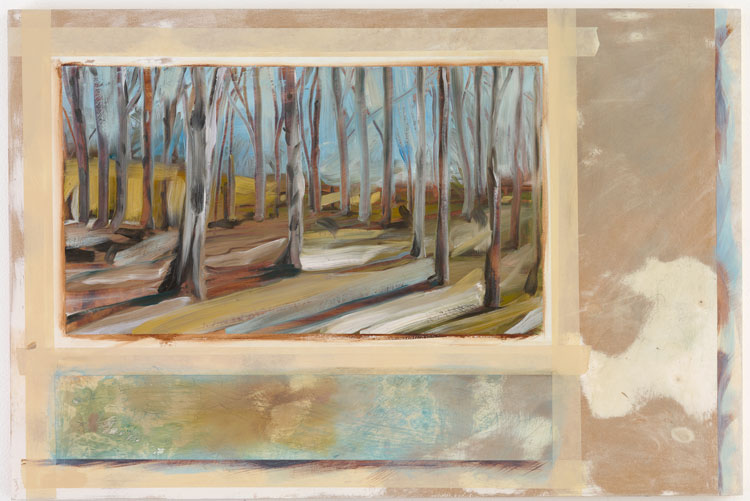
Alastair Gordon. B Flat, 2021. Oil, acrylic and gesso on mdf, 60 x 90 cm. © Alastair Gordon. Courtesy the artist and Aleph Contemporary. Photo: Anna Arca.
DT: In lockdown you offered new works on paper for sale through the Artist Support Pledge. These were mostly drawings of trees in the woods of Tooting Common in south-west London, near to your studio. Is drawing an important aspect of your practice?
AG: I draw every day, come rain or shine, weekend or weekday. Drawing has always been there, ever since I was a student. For me, drawing is a way of seeing, while painting is a means to interpret what I’ve seen. Like a lot of artists, I drew more through lockdown – exhibitions were cancelled and postponed so there was all this free time. I had time to develop ideas that wouldn’t have developed otherwise, and I did a lot more sketchbook work. Because life became so digital, I wanted to get out more, to be grounded in nature. Tooting Common is just up the road and I go running there, so I found myself out there drawing with my sketchbook. I went back to the same place and drew the same tree every time. The drawings became a catalogue of seasonal change, which then started to work their way into the paintings.
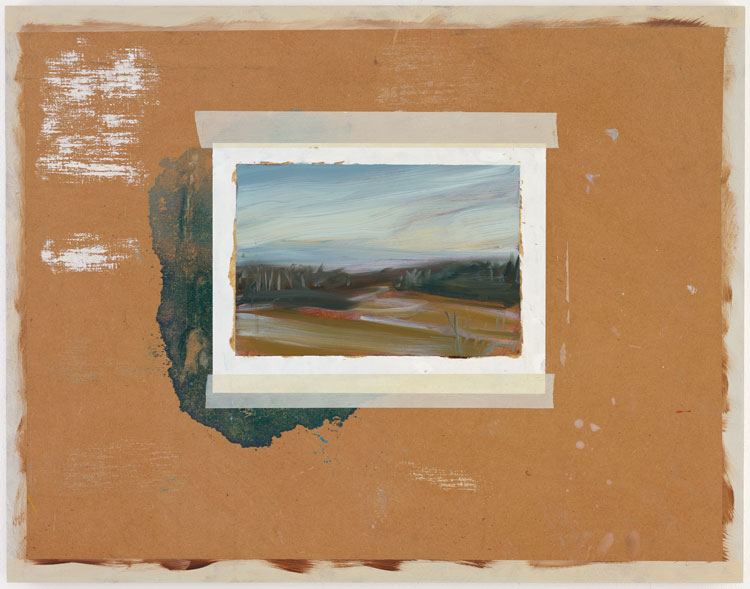
Alastair Gordon. A New Beginning, 2021. Oil and acrylic on mdf, 59 x 76 cm. © Alastair Gordon. Courtesy the artist and Aleph Contemporary. Photo: Anna Arca.
DT: Works such as B Flat (2021) and A New Beginning (2021) treat the painted landscape as a subject of still life. What role does landscape play in these paintings?
AG: They started as a response to the drawings I was making on the commons at Tooting and Wimbledon. Although quodlibet is best known for still life and for incorporating paintings of portraits, every now and again a landscape painting would be included. My own painted landscapes seemed to fit within that tradition: as paintings of drawings of nature, they oscillated between still life and landscape. But I was also just so struck by the wonder of the natural environment and, for want of a better word, the beauty of it. Those two paintings you mentioned were painted in the landscape. Each one began with a substrate and the illusion of a wooden surface, which I then took to Wimbledon Common in order to paint the landscapes as an authentic intuitive response to what I was seeing. They were made really quickly, in about half an hour. That was opposite to the way I made Improvisation (2021), which was painted in the studio from the drawings and paintings that I’d made in the landscape.
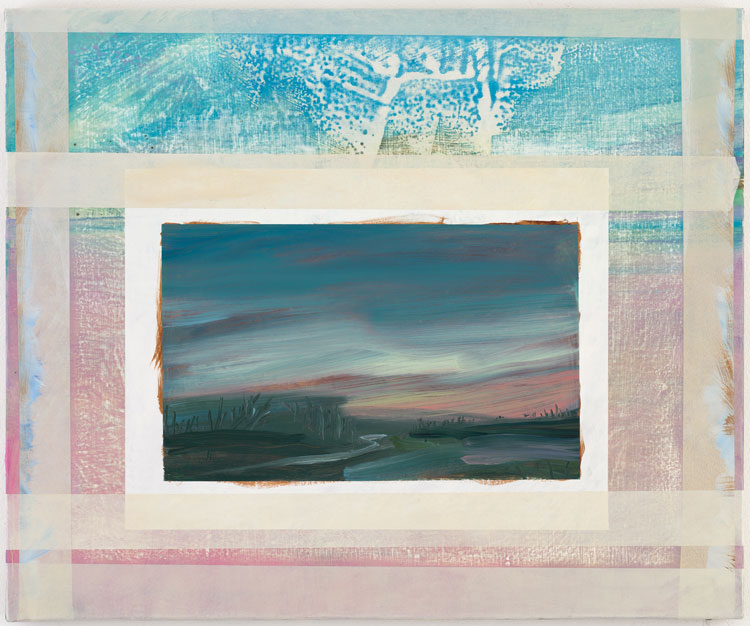
Alastair Gordon. Pink Dawn, 2021. Oil, acrylic and gesso on canvas, 65 x 54 cm. © Alastair Gordon. Courtesy the artist and Aleph Contemporary. Photo: Anna Arca.
DT: Pink Dawn (2021) was another painting that you completed from observation in the landscape. The title seems to suggest a desire to privilege the figurative elements over the incidental, more abstract aspects.
AG: That painting began in the studio as an abstract concern. It’s very linear and geometric; it has the horizontal and vertical lines of masking tape and what began as a white rectangle in the centre. I was wondering what on earth to do with this void and I’d been out on Wimbledon Common, drawing and painting as the sun was rising. I got up early one morning and took the painting out, thinking I could always wipe it back if it was no good. It started to rain as I was painting and in London, when rain is fused with a bit of pollution on the horizon, you get this really glorious pink effect. So that was the painting, made very quickly in the landscape. It’s both figurative and abstract, but the title does place it within a figurative tradition. I think, at heart, I’m more a figurative painter than an abstract painter but, in any case, all paintings are abstract.
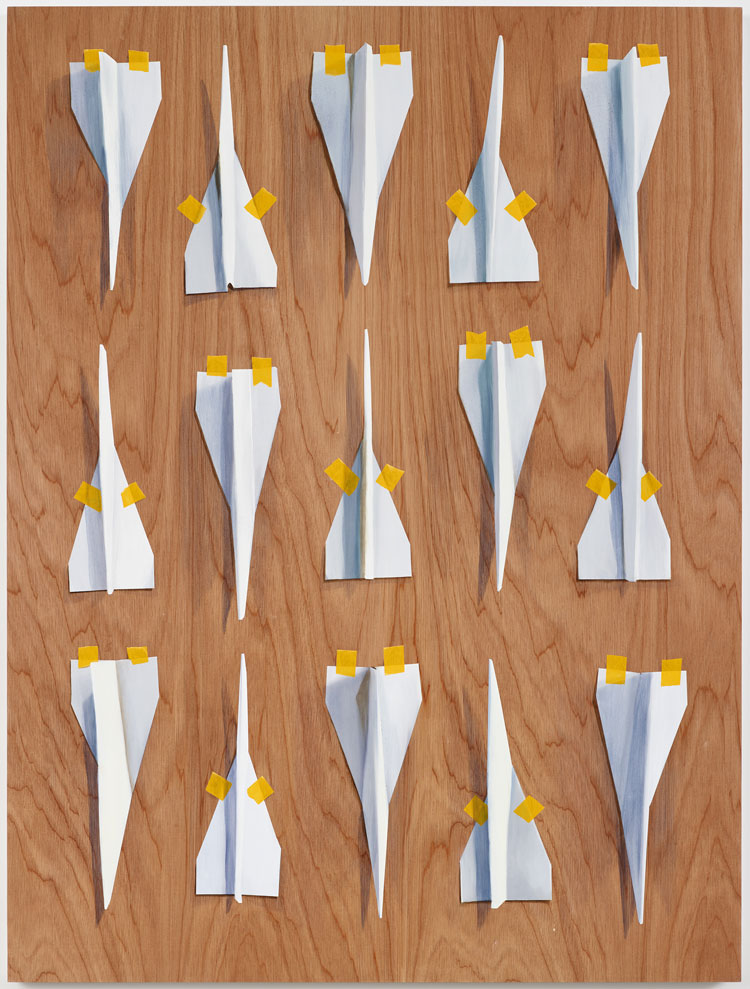
Alastair Gordon. Fifteen Paper Panes, 2018. Oil on wood, 90 x 68 cm. © Alastair Gordon. Courtesy the artist.
DT: The paper aeroplane is a recurring motif, appearing in many of your works. What is its significance?
AG: I began painting the paper aeroplanes about eight years ago, around about the time my wife and I experienced a personal tragedy, but it took me a while to realise why I was painting them. Our daughter had been making paper aeroplanes at the time and, in my mind, they became connected with the loss of our unborn child. They became for me a very personal symbol of lament, a way of mourning the situation we were going through. But then other things started to take over. The aeroplanes are very interesting formally: the triangle that’s not quite a triangle and how it connects with the rectangle of the substrate; they have a low relief so there are some interesting things that happen with shadow and tone. I find myself going back to them quite a lot.
DT: One of your paper aeroplane paintings was used for the cover of your new book, Why Art Matters, an unashamedly Christian take on the importance of the creative arts as seen through the lens of your faith. What prompted you to write it?
AG: When I was a student, I read a few books about faith and art that really helped me: Steve Turner’s Imagine, for example, as well as the writings of Francis Schaeffer and Hans Rookmaaker. I felt there was a need to update some of that material to discuss the importance of the creative arts from the perspective of someone like myself, an artist of faith. There have been a few things written by theologians and theorists but nothing by someone working as an artist. The book’s content developed from various talks and lectures that I’d given through Morphē Arts, the mentoring group I founded for artists interested in things of faith and art. I argue that art matters because, among other things, it helps us to understand the times we live in, to celebrate with greater joy and lament with deeper sorrow; and it can give us hope for something yet to come while reminding us of the value of everyday things.
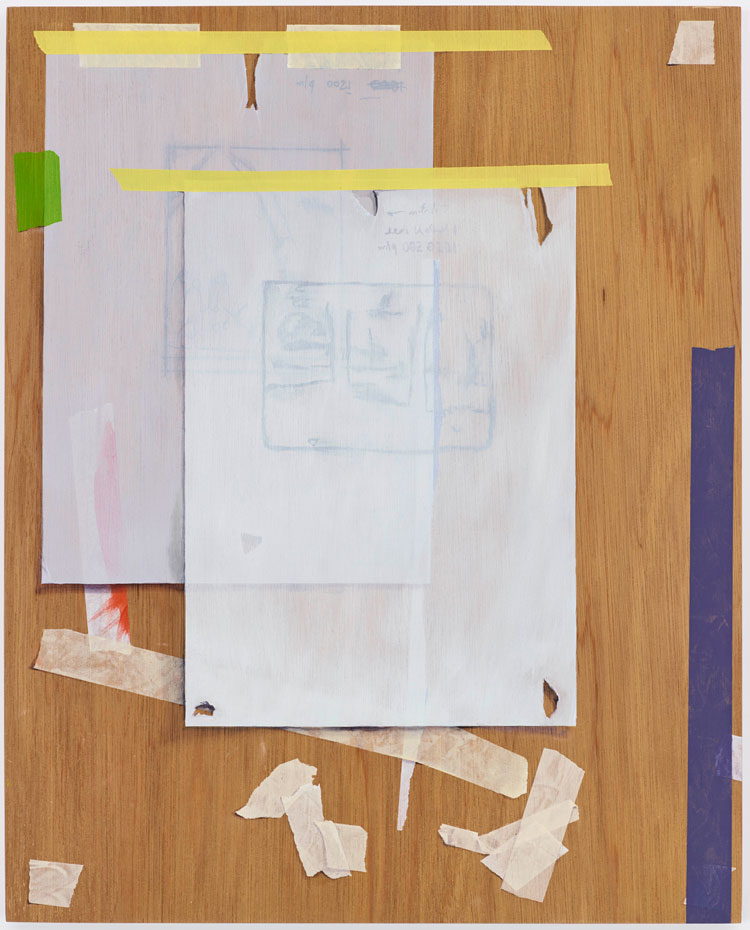
Alastair Gordon. Tabula Rasa, 2016. Oil on gaboon marine ply, 50 x 40 cm. © Alastair Gordon. Courtesy the artist.
DT: In the book you write: “Some might consider faith to be a naive, irrelevant or outdated way of thinking, but I encourage you to read on.” Why should someone who doesn’t share your faith read the book?
AG: All of us to some extent are faithful people, we all believe in something and exist within certain belief structures. And, of course, doubt is part of belief; I entertain that idea that faith and doubt are interconnected, so hopefully there are ways in for those who don’t identify specifically with a Christian tradition. But second to that, the tradition of visual art, and particularly western visual art, has been at times so governed and dictated by the Christian church that to avoid thinking about Christianity and faith in relation to that history is to ignore the foundation of a vast raft of art. In the book, I argue that art matters because it is the voice of human beings and human beings matter. You don’t need to be a Christian to believe that, so for someone reading my book who doesn’t share my faith, my hope is that there will be some conclusions about the importance of art that we might be able to share.
DT: How does your Christian faith inform your practice as an artist?
AG: In every way. Being a Christian is the most important thing in my life and I try to let my faith guide all my conscious decisions. My day begins with prayer. I light a candle at my desk, I say a little liturgical prayer and then open my sketch book and start working on ideas. I ask for God’s help with my work and from there on I start to paint. Those who know me in my corner of the art world might not necessarily know that about me, but it’s absolutely the core of who I am as a human being and of my work. For me, painting and faith are very much intertwined, like the warp and weft of a tapestry.
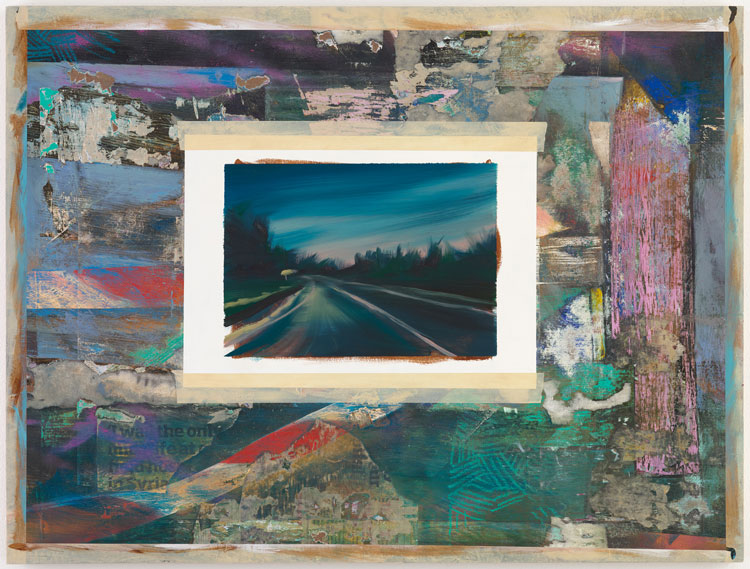
Alastair Gordon. Through a Glass Darkly, 2021. Oil, acrylic and mixed media on marine ply, 68 x 90 cm. © Alastair Gordon. Courtesy the artist and Aleph Contemporary. Photo: Anna Arca.
DT: Jorella Andrews, Reader in Visual Culture at Goldsmiths, University of London, has written that your book’s 10 reflections on why art matters “assemble spiritual insight, practical and personal experience, and theological rumination to present much-needed justifications for the spiritual significance of art especially in the most challenging of contemporary situations”. What, in your view, is the spiritual significance of art?
AG: That question about art and the spiritual has always been there and so many artists have been interested in spirituality. Klee, Matisse, Malevich and Kandinsky, among many others, have unashamedly approached questions of faith and spirituality through the lens of art. When Kandinsky writes about spirituality, he begins with colour, shape and form and how that can signify a transcendent realm. It’s that interconnectedness between what it means to be a human being and what it means to make art that is so interesting. It doesn’t matter whether you identify with a religious tradition or not, the moment you make a mark on canvas, or put colour on paper, you are engaging in a spiritual activity. Our task is to try to describe that for our moment in time, and that is what I try and do in the book and what I hope I’m doing with my painting as well.
DT: Is there still a place for contemporary religious art as opposed to work about, or critical of, religion?
AG: Yes, I think there is. James Elkins addresses this in his book On the Strange Place of Religion in Contemporary Art; he writes about how it is acceptable to approach biblical subjects from a position of cynicism or scepticism, but if you are sincere, if you genuinely believe it, that’s somehow unacceptable. He wonders where the sincere believers are who are making work about their faith. Jonathan Anderson, in his book Modern Art and the Life of a Culture, pushes back a little bit on Elkins, noting that there are in fact loads of artists out there sincerely making great work about their faith, and also artists making work about faith who don’t identify with a believing tradition. The problem, he says, is actually more in critical circles; it’s when it comes to writing about art, that’s where the sticking point is. There is some sort of state of anxiety in the art world about this, where work about faith is not being written about. That requires some unpicking.
DT: Maybe sincere religious belief is the last taboo of art?
AG: I like how Dan Fox put it in Frieze magazine in 2010: “When was the last time you saw an explicitly religious work of contemporary art? Odds are you can’t remember. If you can, it’s because it will have stood out like the Pope in a brothel. Religious art, when it’s not kept safely confined within gilt frames in the medieval departments of major museums, is taboo.” When I was at art school, it was certainly taboo to make work about things of faith, but I sense that less now.
• Alastair Gordon: Quodlibet is at Aleph Contemporary, London, until 29 September 2021. Why Art Matters by Alastair Gordon is published by IVP Books, price £9.99.